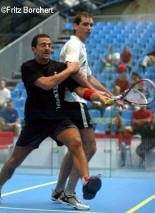| The RULES of Squash
At
times squash seems a simple game. Get on court, run after the ball,
hit it where your opponent can't get it.
But there's a bit more to it than that.
This section gives you access to the full rules of the game, plus
simplified versions, analyses and additional rules resources.
You don't have to learn it all by heart, but a basic knowledge of
the rules is essential, so for newcomers start with the
abbreviated rules and work your
way down the list until you're an expert!
If you have any rule-specific queries try the
Rules FAQ
.
For any other questions you have,
visit the Clinic.
|
|
the MOST
COMMON questions,
and some basics:
- the lines,
and anything else around the court (roof, lights etc) are
OUT
- yes, you
can do a 'tennis' or overarm serve
- the serve must hit the
front wall first, but can hit any other walls, as long as it
lands in the opposite back corner (and yes, you can volley
it)
- in essence, if your swing
is impeded it's a let, if your swing is prevented it's a
stroke
- it's up to you to get out
of the way, if you don't it's a stroke (simplified version!)
|
|
Let Please!
The Interference Line of Thinking ...
|
Refereeing is a thankless but
necessary task. It always helps to know the rules, and to use the
correct calls, but the real 'nitty-gritty' is what you do when one of
the players appeals for a let. Below is a summary of the thought
process a referee should go through when asked 'Let Please'...
|
|
| The
Question ... |
The Answer ... |
| 1. Did interference occur
?
 |
The striker has four basic
rights, and interference has occurred if the opponent fails to provide him
with any of these, even if he has made every effort to do so:
If no interference has occurred, then it's NO LET,
otherwise move on to no.2 |
| 2.
Could the obstructed player have reached the ball and made a good return ?
And was he making every effort to do so ? |
If either answer is NO, then
it's NO LET,
otherwise move on to no.3
|
| 3.
Did the obstructing player make every effort avoid the interference ? |
If he didn't, then it's a
STROKE,
otherwise move on to no.4
|
| 4.
Was the obstructed player in a position to play a winning return ? |
If so, then it's a STROKE,
otherwise it's just a LET |
|
Remember though, that this is a
simplification -
read the rules thoroughly.
The over-riding principle of the
rules is to
ensure
a fair result for both players.
|
|
 |
|
|
|
|
|